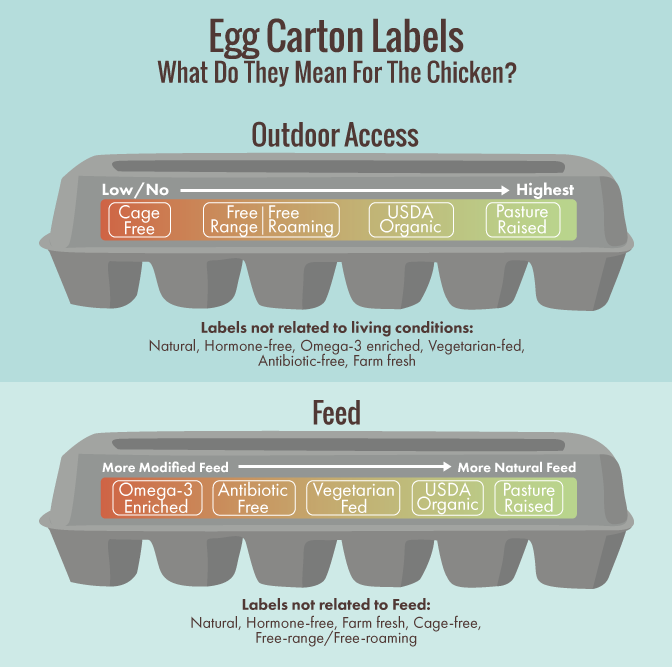How do you like your eggs?
Hard-boiled, over-easy, poached, fried, in an omelette, soft-boiled, sunny-side up, scrambled, frittata-d, baked, shirred?
Personally, I’m a soft-scrambled man. But, it turns out, there are as many types of eggs for sale at your local market as there are ways to prepare them. And not all eggs are created equal when it comes to nutritional value or trying to stick to The Plant Paradox eating plan.
You see, on any given day on the grocer’s shelf, we might find eggs labeled:
>> Organic
>> All natural
>> Cage-free
>> Free-range
>> Certified humane
>> Pasture-raised
>> Hormone-free
So, how do we decode those labels and know which eggs to buy?
The problem isn’t actually the words on the labels themselves, it’s that for us—the consumers—the food and farming industries haven’t provided clear definitions for these terms.
Let’s try to decode these mysterious marketing ploys used by farmers and food distributors.
Category One: Leave These Guys on the Shelf
Now, there are certain labels that marketing companies and factory farms put on packaging to make our purchases seem healthier, but that carry no real weight. The truth is, these are marketing ploys and are not subject to any accredited inspection or United States Department of Agriculture (USDA) standards. So, don’t put too much stock in the following labels:
“Farm Fresh.” It sounds great, right? The phrase “farm fresh” even conjures up a nice image in our minds—the morning sun peeking over rolling hills.
But in reality, it means nothing. We can completely ignore the phrase “farm fresh.” To discover how fresh the eggs we’re buying really are, we’ve got to pay attention to the USDA Grade shield. This is the standard AA, A, B grade we see on egg cartons.
Although the USDA is an independent third party, it’s recognized for assuring eggs meet the proper standards for quality and sanitary processing. Through the USDA, licensed graders appraise facility sanitation, processing procedures, egg quality, weight, and storage temperature.
“No Hormones.” This one’s an odd one because the USDA forbids the use of hormones to begin with. So, whether we see this written on an egg-carton or not doesn’t really matter, because it’s the legal standard. That means every farmer and food distributor must comply. If the notation is there, it’s as if the factory is saying, “Buy our eggs. We didn’t break the law.”
“All Natural.” Again, it sounds great, doesn’t it? And, of course, we want our eggs to be all natural. But, the phrase doesn’t actually mean anything. In fact, it’s just good marketing.
Turns out, “all natural” hens can still be kept in battery cages—a system of tiny, connected cages arranged in rows with common walls, like the cells of a battery. The hens live their whole lives in these cages, unable to move. “All natural” hens might also have their beaks clipped. And, though the name implies no antibiotics are used on the animals, there’s really no guarantee.
Category Two: There’s Some Regulation, but not enough for The Savvy Shopper
“Free-Range.” According to the USDA, “free-range” means the birds are required to have “access” to the outdoors. That’s it—access.
So, hens might be able to see the outdoors, but can by no means roam freely. We have no way of knowing how much time and space the birds are given outdoors—and these regulations are not stipulated by the USDA. So, even if there’s a door or window to the outside, it doesn’t have to be open. These animals are still caged.
Also, a free-range label ignores that these birds are not consuming their natural diet of grasses and proteins—instead they’re fed lectin-rich grains like corn and soybeans. That means these toxic plant proteins are making their way into our eggs.
“Cage-Free.” The Agricultural Marketing Service (a wing of the USDA) considers cage-free birds to be permitted to roam a room, building, or enclosure with access to food and water. But, there’s that dirty word again: access.
These birds are still fed lectin-filled grains and are not guaranteed passage to the outdoors. Again, they’re fed corn and soybeans—even if it’s organic, it’s organic corn and soybeans. The bottom line is corn and soy contain harmful lectins, and we need to do our best to avoid them. So, we should avoid cage-free eggs as well.
Category Three: Take these Home and Enjoy
“Pasture-Raised” or “Pastured.” This is a model of farming in which birds are raised outdoors, for the most part. They’re taken to suitable housing in the cases of inclement weather or to protect them from predators.
Turns out, pastured birds are given acres on which to roam and the pastures on which they graze are rotated to maintain the health of both the soil and the birds. Rotating the pasture allows the chickens to steer clear of their own manure. This method also keeps the grass green, and gives the birds ample opportunity to forage for bugs—mmm, protein!
I tend to look for “Certified Humane Pasture-raised” eggs. When we see this label, it means there’s about 2.5 acres of pasture per 1,000 hens each day. And eggs from pastured hens really are our best bet. Not only are they often more nutritious than other types of eggs, but pastured hens were given free access to the outdoors and, as a result, they get to eat their natural lectin-light diet.
“Omega-3.” Omega-3 eggs are a special category of egg laid by hens who consume a natural diet enhanced with flaxseed. When the flax is digested, the polyunsaturated omega-3 fatty acid gets transferred to the yolk. In a recent study, omega-3 eggs had approximately five times as much omega-3 fatty acid as conventional eggs. They’ve also been shown to help lower blood pressure.
No matter how we like our eggs—scrambled, over-easy, poached, or fried—it’s best when we can get pastured or omega-3 eggs on our plates. Because, you are what the chicken eats—so if they eat lectin bombs, then you do too when you eat their meat or eggs.
Author: Steven Gundry
Image: Fix.com
Editor: Emily Bartran









Read 0 comments and reply